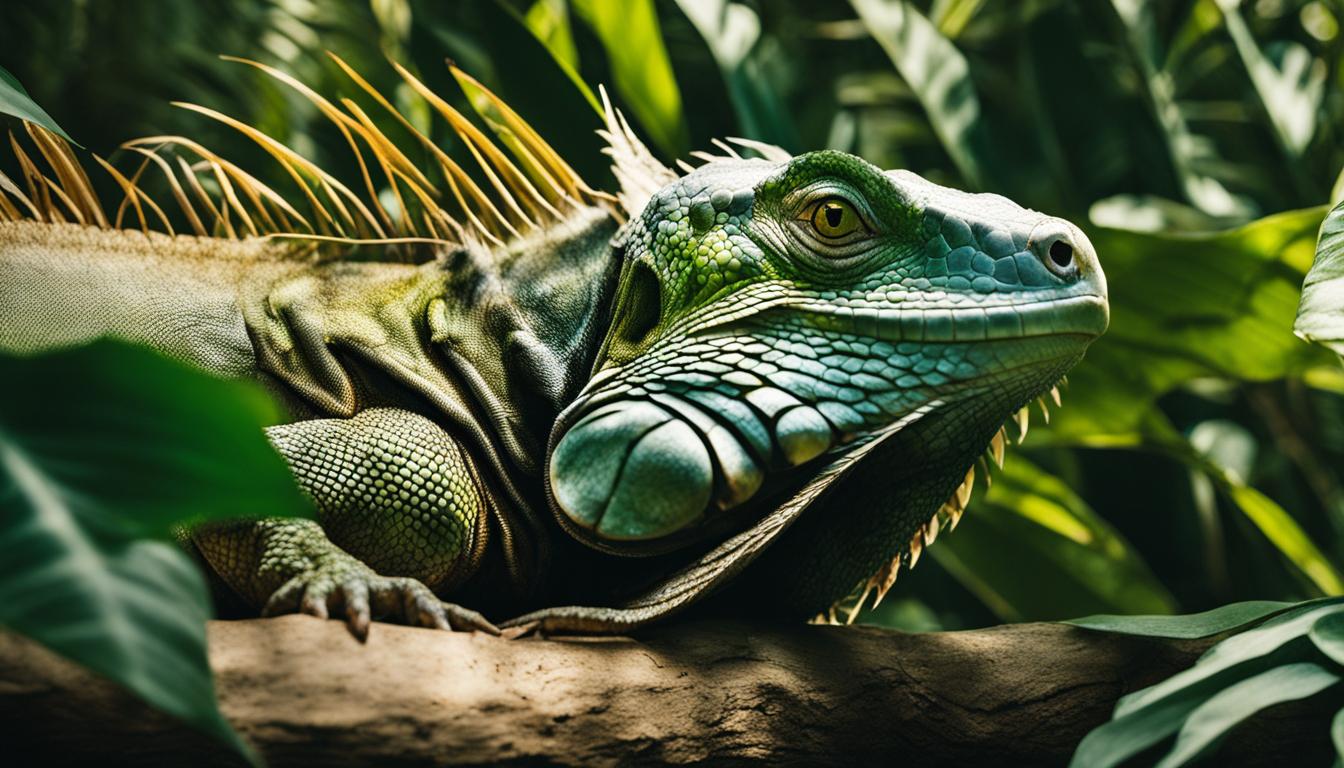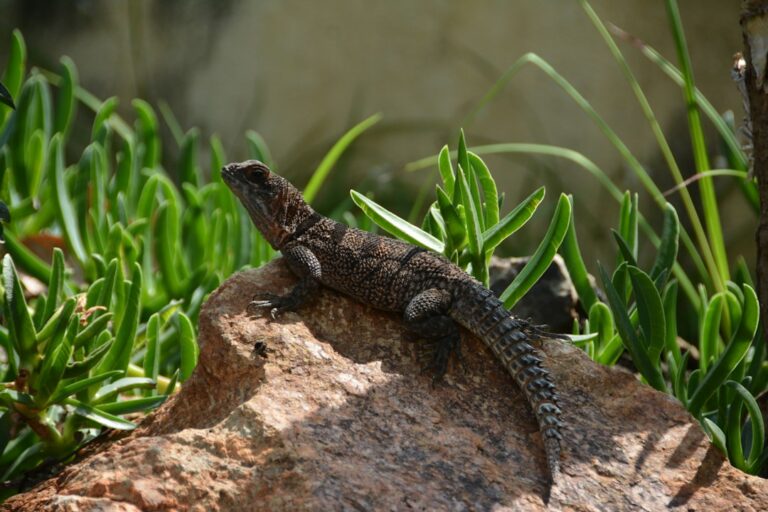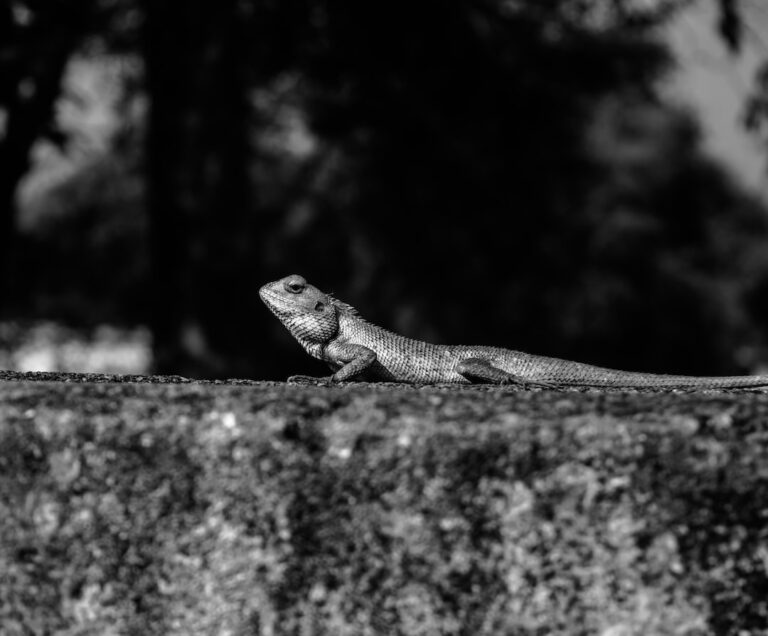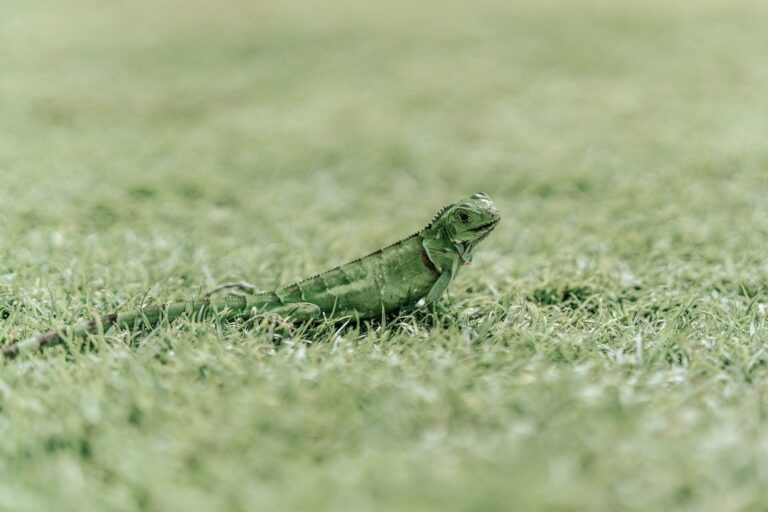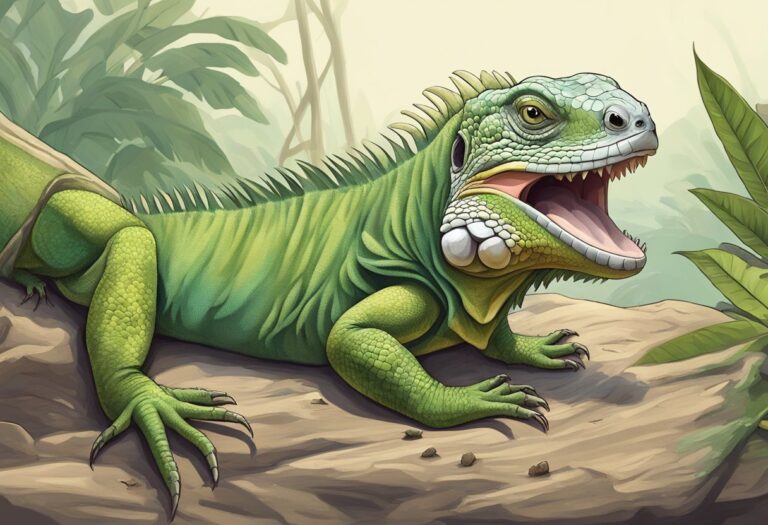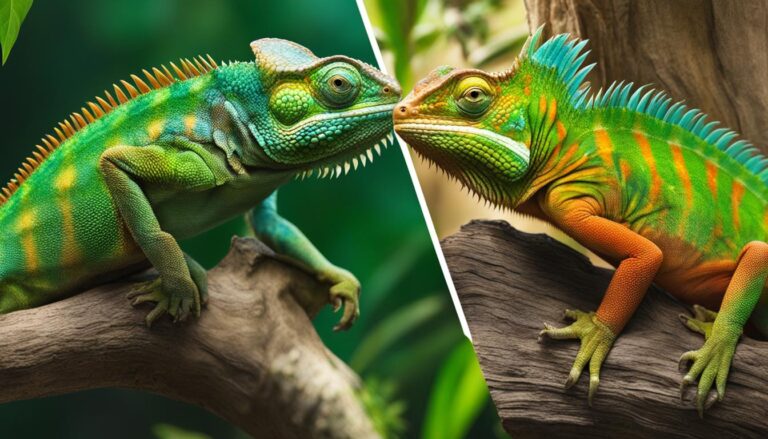How Long Do Iguanas Play Dead?
Welcome to our article exploring the intriguing behavior of iguanas playing dead. Have you ever wondered how long these reptiles can pretend to be lifeless in order to survive in the wild? Join us as we delve into the world of iguanas’ self-defense mechanisms and uncover the duration of their playing dead act.
Iguanas possess a remarkable defense mechanism known as thanatosis, where they play dead to deceive predators and increase their chances of survival. But how long can they keep up this act of self-preservation? Let’s find out!
In this article, we will explore the various factors that influence the duration of time iguanas play dead. From instinctive behavior to observational studies, we will decode the strategy behind their seemingly lifeless state. Additionally, we will analyze the efficacy of playing dead as a predatory deterrent and compare the differences between iguanas’ behavior on land and in water.
But that’s not all! We will also examine the physiological changes that occur in iguanas during thanatosis, providing insights into their respiration and heart rate. Furthermore, we’ll discuss similar survival tactics utilized by other reptiles, while also distinguishing genuine playing dead behavior from potential health issues.
So, if you’re fascinated by the wonders of the natural world and curious about how our scaly friends navigate the precarious realm of self-defense, this article is for you! Join us on this exciting journey as we uncover the secrets of how long iguanas play dead in order to survive.
Table of Contents
Key Takeaways:
- Iguanas employ the defense mechanism of playing dead to protect themselves from predators.
- The duration of iguanas playing dead can vary and is influenced by various factors.
- Observational studies shed light on the instinctive nature of playing dead in iguanas.
- Iguanas’ playing dead behavior is effective in deceptive predator avoidance.
- Understanding the difference between genuine thanatosis and potential health issues is crucial for iguana owners and enthusiasts.
Insights Into Iguana Thanatosis
In this section, we will delve into the instinctive nature of iguanas playing dead as a defense mechanism. We will explore the observational studies conducted in natural habitats to understand the reasons behind this behavior and its effectiveness in protecting the iguanas from predators.
The Instinctive Nature of Playing Dead
Iguana thanatosis, commonly known as playing dead, is an instinctive behavior exhibited by iguanas when they perceive a threat. In the face of danger, iguanas instinctively rely on this defense mechanism to confuse predators and increase their chances of survival. By playing dead, iguanas make themselves appear unappetizing or already deceased, reducing their appeal as a potential meal.
Observational Studies in Natural Habitats
Observational studies conducted in the natural habitats of iguanas have provided valuable insights into the reasons behind their playing dead instincts. These studies have revealed that iguanas primarily resort to thanatosis when confronted with predators that rely on visual cues to identify and capture their prey. By feigning death, iguanas successfully evade potential threats by effectively camouflaging themselves within their surroundings.
Decoding the Strategy Behind Iguanas Playing Dead
In the previous section, we explored the instinctive nature of iguanas playing dead as a defense mechanism. Now, let’s delve deeper and decode the strategy behind this fascinating behavior.
Playing dead is a self-defense mechanism that iguanas employ to avoid predators and ensure their survival in the wild. By feigning death, these remarkable reptiles trick their would-be attackers, making them believe that the iguana is an inanimate object rather than prey.
This strategy allows iguanas to deceive predators and gain an advantageous position. While the predator’s attention is diverted or its predatory instincts temporarily appeased, the iguana can make a quick escape to safety. This survival strategy has been honed over years of evolution, making it an effective defense mechanism for these reptiles.
Playing dead is not a sign of weakness; it is a strategic move in the iguana’s self-preservation playbook, allowing them to outwit potential predators and live to see another day.
Decoding the strategy behind iguanas playing dead involves understanding the predator avoidance tactics employed by these reptiles. By effectively mimicking death, iguanas capitalize on the hesitation of predators and their instinctual aversion to consuming deceased prey.
This self-defense mechanism serves as a crucial survival strategy for iguanas, allowing them to navigate their natural habitats with increased safety and reducing the risk of predation. By mastering the art of playing dead, iguanas have evolved a unique strategy that helps them thrive in their environments.
Comparing Iguanas’ Playing Dead Strategy with Other Survival Tactics
| Survival Tactics | Advantages | Disadvantages |
|---|---|---|
| Camouflage | Allows concealment from predators | Requires a habitat with suitable hiding spots |
| Armored Scales | Provides physical protection | Slows down mobility |
| Running and Climbing | Allows escape from predators | Might not be effective against certain predators |
| Playing Dead | Deceives predators and buys time for escape | Relies on accurate mimicry and timing |
Iguanas’ Defense Mechanism in Water
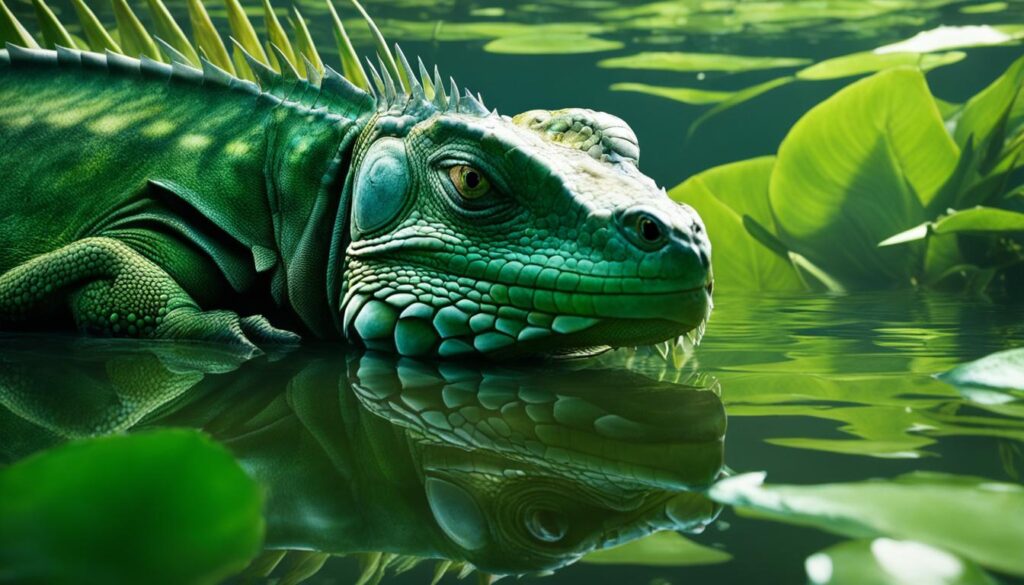
When it comes to survival in predatory waters, iguanas possess a unique defense mechanism – playing dead. This behavior allows them to evade potential predators and increase their chances of survival. Let’s explore how iguanas utilize this intriguing defense strategy and delve into the differences between human perception and predator response.
Floating Motionless: Survival in Predatory Waters
When threatened in aquatic environments, iguanas have the ability to seamlessly transition from their usual agile state to a motionless posture. They will float on the water’s surface, resembling lifeless debris. This deceptive tactic confuses and deters predators, giving iguanas valuable time and the advantage to escape attack.
Their ability to remain perfectly still while submerged is key to their survival. By mimicking inanimate objects, such as fallen branches or leaves, iguanas camouflage themselves and become virtually invisible to predators lurking beneath the surface. This remarkable adaptation allows them to navigate and survive in the perilous world of predatory waters.
Human Perception vs. Predator Response
While humans may perceive iguanas’ playing dead behavior as a sign of weakness or vulnerability, it is quite the opposite in the eyes of their natural predators. Predators, such as birds of prey and larger aquatic predators, rely on movement and visual cues to detect potential prey. When an iguana appears lifeless and motionless, it diminishes their interest and decreases the likelihood of an attack.
However, human perception may not always align with the predator response. As observers, it is important to understand and respect the unique defense mechanisms of different species, including the fascinating strategy of playing dead employed by iguanas. By recognizing and appreciating the survival adaptations of these remarkable creatures, we can gain a deeper understanding of the intricate workings of nature.
In the image above, an iguana can be seen floating motionless in the water, utilizing its defense mechanism of playing dead to survive in predatory waters.
Playing Dead On Land versus Water: Assessing the Differences
When it comes to self-preservation and predator evasion, iguanas have developed a fascinating defense strategy – playing dead. This behavior is commonly observed in both land and water environments, but are there any differences in how iguanas employ this tactic? In this section, we will explore the distinctions between playing dead on land versus water and assess the nuances of iguanas’ defense strategy.
“Playing dead is a remarkable behavior observed in iguanas, allowing them to confuse and evade predators. But does this behavior remain consistent across different habitats?” – Dr. Jane Wilson, Iguana Behavior Expert
To understand the differences in playing dead on land versus in water, we need to consider the unique challenges and opportunities presented by each environment. On land, iguanas rely on their ability to blend into their surroundings and remain motionless, mimicking the appearance of a lifeless creature. This strategy aims to confuse predators and discourage further pursuit.
In contrast, playing dead in water requires a different approach. When faced with a predator while swimming, iguanas exhibit a behavior known as “floating motionless.” In this state, iguanas remain still on the water’s surface, conserving energy and relying on their innate camouflage to blend in with the surrounding vegetation.
By assessing the differences between playing dead on land and in water, we gain insight into the adaptability and versatility of iguanas’ defense strategy. The ability to adapt their tactics depending on the environment showcases the remarkable survival instincts these reptiles possess.
Now let’s take a closer look at some key differences between iguanas’ defense strategy on land and in water:
| Playing Dead on Land | Playing Dead in Water |
|---|---|
| – Blending into the surroundings | – Floating motionless on the water’s surface |
| – Remaining motionless | – Conserving energy |
| – Mimicking the appearance of a lifeless creature | – Camouflaging with surrounding vegetation |
| – Discouraging further pursuit by confusing predators | – Relying on innate camouflage to deter predators |
Through careful assessment, we can appreciate the adaptability of iguanas’ defense strategy, showcasing their ability to leverage their environment to ensure survival. Whether it’s playing dead on land or in water, iguanas utilize their self-preservation instincts to evade predators and secure their place in the ever-challenging natural world.
How Long Do Iguanas Play Dead
In the previous sections, we have explored the fascinating behavior of iguanas playing dead as a defense mechanism. Now, let’s delve into the duration of time that iguanas exhibit this behavior and the factors that influence its length.
The Range of Thanatosis Duration in Iguanas
The duration of thanatosis, or playing dead, can vary among iguanas. Some individuals may play dead for a few minutes, while others may remain motionless for up to an hour or more. This range of duration allows the iguana to create a convincing illusion of death and increase their chances of survival.
To understand this range better, let’s take a closer look at the factors that influence the length of thanatosis behavior.
Factors Influencing the Length of the Behavior
Several factors can influence how long an iguana plays dead:
- Perceived threat level: The intensity of the perceived threat plays a significant role in determining the duration of thanatosis. If the iguana senses a high level of danger, they may prolong their motionless state to ensure the predator loses interest.
- Predator behavior: The behavior of the predator can also impact how long an iguana plays dead. Some predators may lose interest quickly, while others may persist in their pursuit. Iguanas may adjust the duration of their thanatosis response accordingly to outlast their predator.
- Environmental conditions: Environmental factors, such as temperature, humidity, and available cover, can influence the length of thanatosis behavior. In certain conditions, iguanas may prolong playing dead to increase their chances of escaping undetected.
- Individual traits: Each iguana may have unique characteristics and tendencies that influence their thanatosis behavior. Factors such as age, experience, and overall temperament may contribute to variations in the duration of playing dead.
By adapting the duration of playing dead, iguanas demonstrate their remarkable survival strategy and defense mechanism for evading predators.
| Factors | Influence |
|---|---|
| Perceived threat level | High threat level may prolong the duration of thanatosis to ensure predator loses interest. |
| Predator behavior | Different predator behavior may impact how long iguanas play dead. |
| Environmental conditions | Environmental factors can influence the length of thanatosis behavior. |
| Individual traits | Age, experience, and temperament of individual iguanas may contribute to variations in duration. |
Examining Iguanas’ Respiration and Heart Rate During Thanatosis
During thanatosis, iguanas undergo various physiological changes, including alterations in respiration and heart rate. These changes are crucial for their self-defense mechanism and survival in the face of predators. Let’s explore how iguanas’ respiration and heart rate are affected during this behavior.
When an iguana enters thanatosis, its respiration slows down significantly. This reduction in respiratory rate helps conserve energy and ensures the iguana remains motionless, appearing dead to potential threats. The decrease in respiration also enables the iguana to conserve water, an essential resource in arid environments where these reptiles often reside.
As for heart rate, iguanas experience a decrease during thanatosis. The heart beats at a slower pace, further contributing to the appearance of lifelessness. This reduced heart rate not only helps conserve energy but also allows the iguana to maintain a state of calmness and stillness necessary to deceive predators.
The physiological changes in respiration and heart rate that occur during thanatosis serve as a remarkable self-defense mechanism for iguanas. By appearing motionless and lifeless, these reptiles trick predators into believing they are not a threat or potential prey, increasing their chances of survival in the wild.
“During thanatosis, iguanas utilize their respiration and heart rate to fool predators and ensure their own survival.” – Experts in Iguana Behavior
In the next section, we will analyze the efficacy of playing dead as a predatory deterrent for iguanas. We will delve deeper into the mind games played between prey and predator, examining the success rate of thanatosis as a defensive strategy.
The Efficacy of Playing Dead as a Predatory Deterrent
In this section, we will analyze the efficacy of playing dead as a predatory deterrent for iguanas. Playing dead is a defense strategy employed by iguanas to confuse and deter their predators. By mimicking the appearance of a lifeless prey, iguanas engage in a fascinating game of deception and survival.
Prey vs. Predator: The Mind Games of Iguanas
Iguanas understand the mind games involved in their interaction with predators. By playing dead, they exploit the predators’ instincts and expectations, creating a false sense of security. Predators are often drawn to active and reactive prey, so when an iguana suddenly appears lifeless, it disrupts the predator’s hunting strategy and triggers confusion.
This defensive tactic leverages the predator’s instinctive response to motion and movement. The sudden lack of response from the prey can confuse predators, allowing the iguana an opportunity to escape or find a safe hiding place. By staying perfectly still, the iguana sends a conflicting signal to the predator, making it difficult for them to assess the threat or make an accurate judgment.
Analyzing the Success Rate of Thanatosis
But how successful is playing dead as a defensive strategy for iguanas? The success rate of thanatosis is quite remarkable. Iguanas have evolved to have a high degree of playing dead efficacy, allowing them to escape from predators and survive in the wild.
While the success rate may vary depending on the specific circumstances, observational studies have shown that playing dead provides iguanas with a significant advantage. It increases their chances of evading detection, ensuring a higher probability of survival. The predator’s confusion and hesitation, combined with the iguana’s ability to remain motionless and blend in with the environment, make the chances of escape much greater.
Overall, the efficacy of playing dead as a predatory deterrent highlights the clever and adaptive nature of iguanas as a defensive strategy. By engaging in mind games and utilizing thanatosis, iguanas have developed a successful survival mechanism that allows them to outsmart and evade their predators.
Similar Survival Tactics in Reptiles
Reptiles, like iguanas, have developed various self-defense mechanisms to survive in their environments and evade predators. While iguanas are known for their playing dead behavior, other reptiles also employ similar tactics to ensure their survival.
One commonly observed self-defense mechanism in reptiles is camouflage. Many reptiles have evolved to blend in with their surroundings, allowing them to stay hidden from predators. This camouflage can be in the form of colors, patterns, or textures that mimic the environment they inhabit.
Another survival tactic used by reptiles is their ability to regrow lost body parts. This remarkable adaptation, known as regeneration, enables reptiles to recover from injuries inflicted by predators or accidents. For example, some lizards can regrow their tails, while certain species of turtles can regenerate damaged shells.
In addition to camouflage and regeneration, some reptiles employ threatening displays as a form of self-defense. For instance, certain snakes can inflate their bodies, hiss loudly, and exhibit vibrant colors when threatened, deterring potential predators.
Playing dead is another common defense mechanism used by reptiles. Like iguanas, reptiles such as snakes and turtles may adopt a motionless state to trick predators into thinking they are deceased. This behavior not only confuses predators but also provides reptiles with an opportunity to escape their imminent threats.
Moreover, reptiles may rely on predator evasion techniques such as quick movements, agility, and the ability to retreat to safe hiding spots. Their natural instincts and physical capabilities allow them to outmaneuver predators and increase their chances of survival.
Understanding the range of survival tactics employed by reptiles sheds light on the diversity of strategies these animals possess to protect themselves. This knowledge contributes to our overall understanding of reptilian behavior and their coexistence with predators in the wild.
| Reptile | Survival Tactic |
|---|---|
| Iguana | Playing dead behavior |
| Sand boa snake | Camouflage techniques |
| Gecko | Regeneration of lost tail |
| Frilled lizard | Threatening display |
| Green turtle | Quick movements and retreat |
Distinguishing Genuine Playing Dead From Health Issues
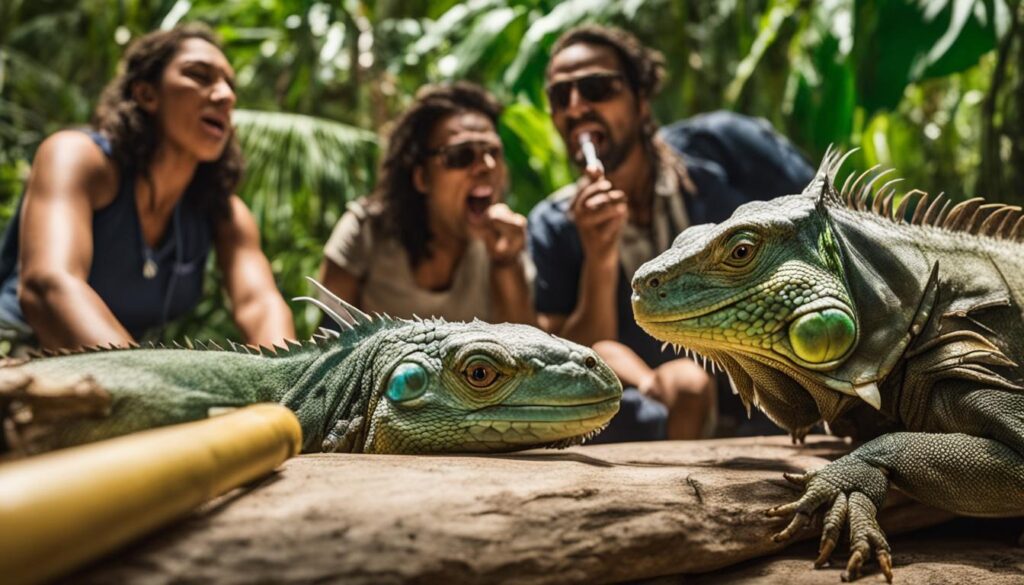
In this section, we will discuss how to differentiate between genuine playing dead behavior in iguanas and health issues that may mimic it. It is important to understand the difference, as recognizing signs of a medical emergency can be crucial in providing timely care and ensuring the well-being of these fascinating reptiles.
Paralysis or Thanatosis? How to Tell the Difference
Paralysis and thanatosis are two distinct conditions that may manifest similarly in iguanas. It is essential to recognize the dissimilarities in order to accurately identify the behavior displayed. Paralysis is the loss of voluntary muscle control, resulting in an inability to move, whereas thanatosis is a specific self-defense mechanism in which an iguana voluntarily immobilizes itself to appear dead to potential predators.
Signs and Symptoms of a True Medical Emergency
While playing dead can be a normal behavior for iguanas, certain signs and symptoms should raise concerns and be regarded as potential medical emergencies. These may include:
- Complete immobility lasting longer than usual thanatosis duration
- Limpness without responsiveness to stimuli
- Difficulty breathing or gasping for air
- Abnormal body contortions or twitching
- Bleeding or wounds
- Visible signs of seizures or tremors
If any of these signs are observed, it is vital to seek immediate veterinary attention as it could indicate a serious health issue requiring prompt intervention.
| Signs of Genuine Thanatosis | Signs of Health Issues |
|---|---|
| Iguana remains motionless for a relatively short period of time | Iguana shows ongoing paralysis or immobility |
| Iguana may still respond or react to external stimuli | There is no response to stimuli or touch |
| Iguana resumes its normal activity after playing dead | There is no improvement in mobility or behavior over time |
| Normal breathing and respiration are exhibited | Irregular or labored breathing is observed |
Conclusion
The Evolutionary Significance of Thanatosis Among Iguanas
Throughout this article, we have explored the fascinating behavior of thanatosis (playing dead) in iguanas and its importance in ensuring their survival. Thanatosis, although a defense mechanism, serves a greater evolutionary purpose for these remarkable creatures.
By playing dead, iguanas are able to deceive predators and escape imminent danger. This behavior has evolved over time as a successful strategy to avoid becoming a prey. When faced with a threatening situation, iguanas instinctively rely on thanatosis as a means to protect themselves and increase their chances of survival.
Moreover, thanatosis among iguanas has been observed across different species and their natural habitats. This indicates that playing dead is not just a learned response, but an innate behavior deeply rooted in their biology. It showcases the remarkable adaptation and resilience of these reptiles.
Practical Advice for Iguana Pet Owners and Enthusiasts
If you are an iguana pet owner or enthusiast, it is important to understand and handle the playing dead behavior in a responsible manner. It is a natural instinct for iguanas, and attempting to suppress or disrupt it can cause stress to your pet.
Instead, provide your iguana with a safe and secure environment where they feel comfortable and can exhibit their natural behaviors. Ensure their enclosure is spacious, enriched with appropriate hiding spots, and free from potential stressors.
Additionally, regularly interact with your iguana, gently handling and gradually exposing them to different stimuli to build their confidence and trust. This will help them feel more secure in their surroundings, reducing the need to resort to thanatosis as a defense mechanism.
In conclusion, thanatosis plays a significant role in the evolutionary history of iguanas, serving as a remarkable survival strategy. Understanding and respecting this behavior is essential for iguana pet owners and enthusiasts who wish to provide the best care for their scaly companions. By embracing the natural instincts of these incredible reptiles, we can ensure their well-being and contribute to their continued survival in both the wild and our homes.
FAQ
How long do iguanas play dead?
The duration of iguanas playing dead can vary, but it typically lasts for around 20 minutes.
Why do iguanas play dead?
Playing dead is one of the iguanas’ defensive mechanisms. It allows them to appear lifeless and motionless, reducing the chances of attracting a predator’s attention.
Is playing dead a way for an iguana to survive?
Yes, playing dead is an important self-defense mechanism for iguanas to avoid predation and increase their chances of survival in the wild.
How does an iguana play dead?
When an iguana is threatened, it will freeze in place, stop moving, and remain motionless for a period of time, giving the appearance of being lifeless.
Can I observe an iguana playing dead if I touch it?
It’s important to avoid touching or agitating an iguana, as this may cause it to react defensively and not exhibit the behavior of playing dead.
Is it unusual for an iguana to play dead?
No, playing dead is one of the defensive behaviors observed in many animals, including iguanas.
Does an iguana come back to life after playing dead?
Yes, an iguana will eventually come back to its normal state and resume its activities once the perceived threat has passed.
Does the playing dead behavior occur in all species of iguanas?
Yes, the playing dead behavior is observed in various species of iguanas as a self-defense mechanism.
How does playing dead help an iguana in self-defense?
Playing dead allows the iguana to appear smaller and less threatening to a predator, increasing its chances of remaining unnoticed or being perceived as a low-value target.
Can I have an iguana as a pet, and will it play dead?
While iguanas can be kept as pets, playing dead is not a behavior commonly observed in captive iguanas. It is more commonly seen in wild iguanas in their natural habitat.

